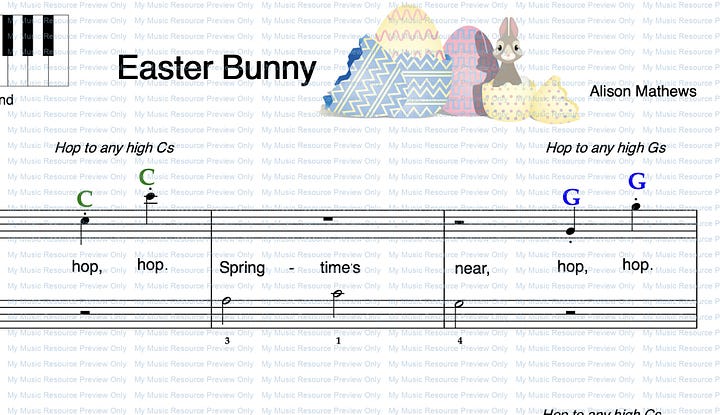3 elementary Easter composition activities
These will put a smile on your students' faces!
Good elementary composition activities need to be simple and fun, and ideally they’re also something you can complete in less than 10 minutes, so that your younger students’ attention spans don’t wander. Here are 3 simple activities I’ve used sucessfully with my youngest students.
Add your own creative twists to an Easter piece
Alison Mathews’ “Easter Bunny” is a perfect activity to ease an elementary student into piano creativity. They’ll learn a fun pre-written piece and are then given plenty of opportunities to add their own creative twists, including choosing the register, adding ornamentation, writing their own lyrics, and extending the composition. The twists are so playful and varied that it’s sure to captivate young students and the bunny hops are a fun way to practise position changes. There’s also the option to practise ensemble playing with a charming duet.




Click here to get Alison Mathews’ “Easter Bunny” on www.mymusicresource.com.
Choose the pitch to fit the lyrics
“See the bunny” from Susan Paradis’ Seasonal Composing Activities bundle — there’s also a notation version
Spring Composition Activity from Susan Lotkowictz — this is a free download!
These two worksheets are a good activity for a student who has been learning for a few months, who is growing in confidence with musical experimentation, but who still needs plenty of helpful guidelines to get started. They’re given an elementary rhythm coupled with seasonal lyrics and are asked to choose a pitch for each note.
It’s effective because it’s so simple: just restrict the students to a small range of notes (e.g. the C major five-finger scale) and identify the tonic note (C if you’re using the C major five-finger scale) where they should end.
I used Susan Paradis’ “See The Bunny” last week with a 7-year old girl, and her giant smile at the end of the activity told me that she was clearly very proud of her work!
Tips:
Susan Paradis’s instruction sheet is good quality — be sure to read it!
when explaining this to younger students you might prefer to explain the tonic as the “home note”
if they come up with a good melody, encourage them to repeat it but change one or two notes
encourage them to experiment by playing the notes themselves. Reassure nervous students that when they’re the composer, there’s no such thing as a wrong note!
play them what they’ve written so that they can hear it played with the correct rhythm
if you’re confident at harmonisation, you could add an accompaniment to their finished piece
As a side note, I was really saddened to learn that Susan Paradis recently passed away. Her website was an enormous help when I was first getting started as a teacher and I often use her fun games to reinforce elementary music theory concepts. I’m in her debt. Thank you Susan. Rest in peace.


Susan Paradis’ Pre-Reading and Reading Composing bundles are here, and Victoria Lotkowictz’s worksheet is here.
I hope you find these useful! Do you have any Easter themed composition activities? Please let me know by replying to this email!


